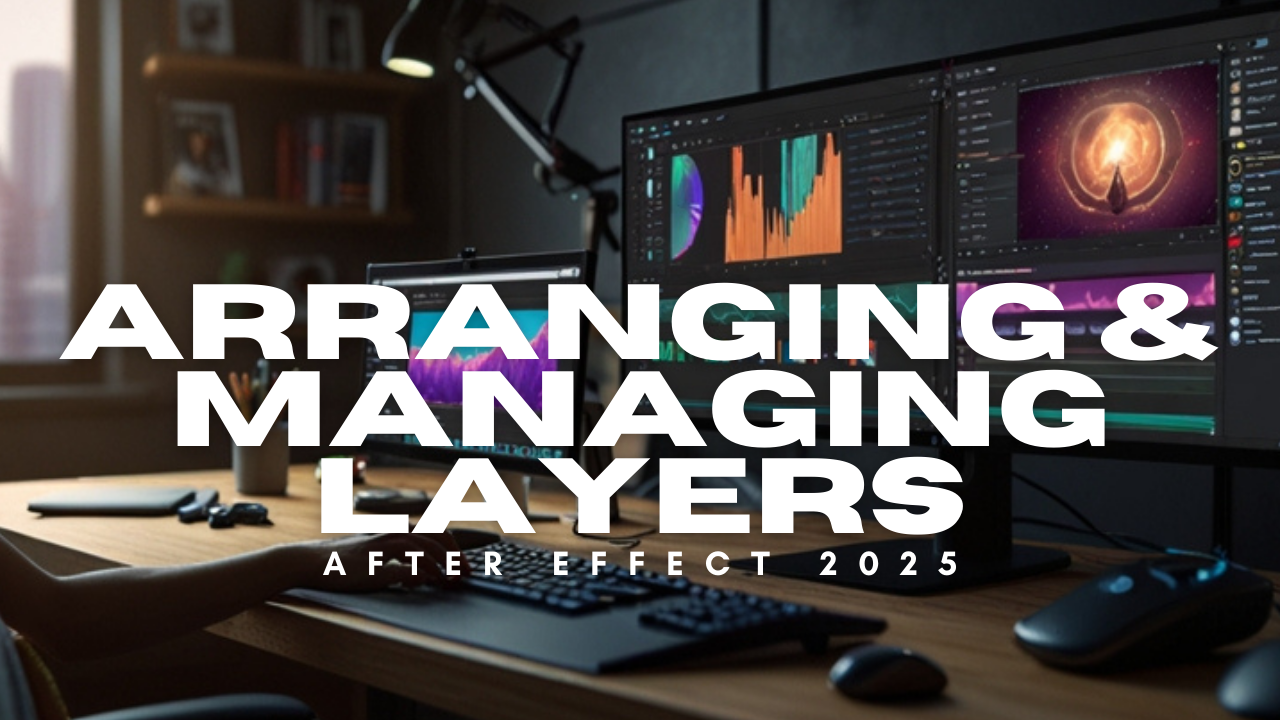
Created by - Anil Chauhan
Arranging And Managing Layers
In Adobe After Effects, arranging and managing layers is crucial for creating organized, efficient, and visually cohesive compositions. Here’s an overview:Arranging Layers Layer Order: Layers are stacked in the Timeline Panel, and the order determines their visual appearance in the composition. Top layers appear in front of lower layers. Reordering Layers: Drag layers up or down in the Timeline Panel to change their stacking order. Align and Distribute: Use the Align Panel to position layers accurately relative to each other or the composition. The Distribute options evenly space multiple layers. Parenting Layers: Use the Parent & Link column to connect layers so that transformations (e.g., position, scale) on the parent layer affect the child layers. Grouping Layers (Pre-composing): Select multiple layers and pre-compose them (Ctrl + Shift + C or Cmd + Shift + C). Combines them into a single composition for cleaner organization. Managing Layers Renaming Layers: Rename layers for clarity by pressing Enter (Windows) or Return (Mac). Color Coding: Assign colors to layers using the Label column to group and differentiate them. Locking Layers: Lock layers (padlock icon) to prevent accidental edits. Shy Layers: Mark layers as shy (face icon) and toggle the "Shy Layers" switch to hide them in the timeline while keeping them in the composition. Solo and Mute Layers: Use the Solo (dot icon) to isolate layers for focused editing. Use the Mute/Hide Audio (speaker icon) to disable sound for specific layers. Layer Shortcuts Transform Properties: P: Position S: Scale R: Rotation T: Opacity A: Anchor Point Toggle Visibility: Ctrl + Shift + H (Windows) or Cmd + Shift + H (Mac). Duplicating Layers: Ctrl + D (Windows) or Cmd + D (Mac). Trimming Layers: Alt + [ or Alt + ] (Windows) / Option + [ or Option + ] (Mac) to adjust in/out points. Best Practices Organize Layers: Use descriptive names and group related layers in folders. Minimize Clutter: Use shy layers and pre-compositions for complex projects. Stay Consistent: Use consistent color codes and naming conventions.
More detailsPublished - Wed, 22 Jan 2025
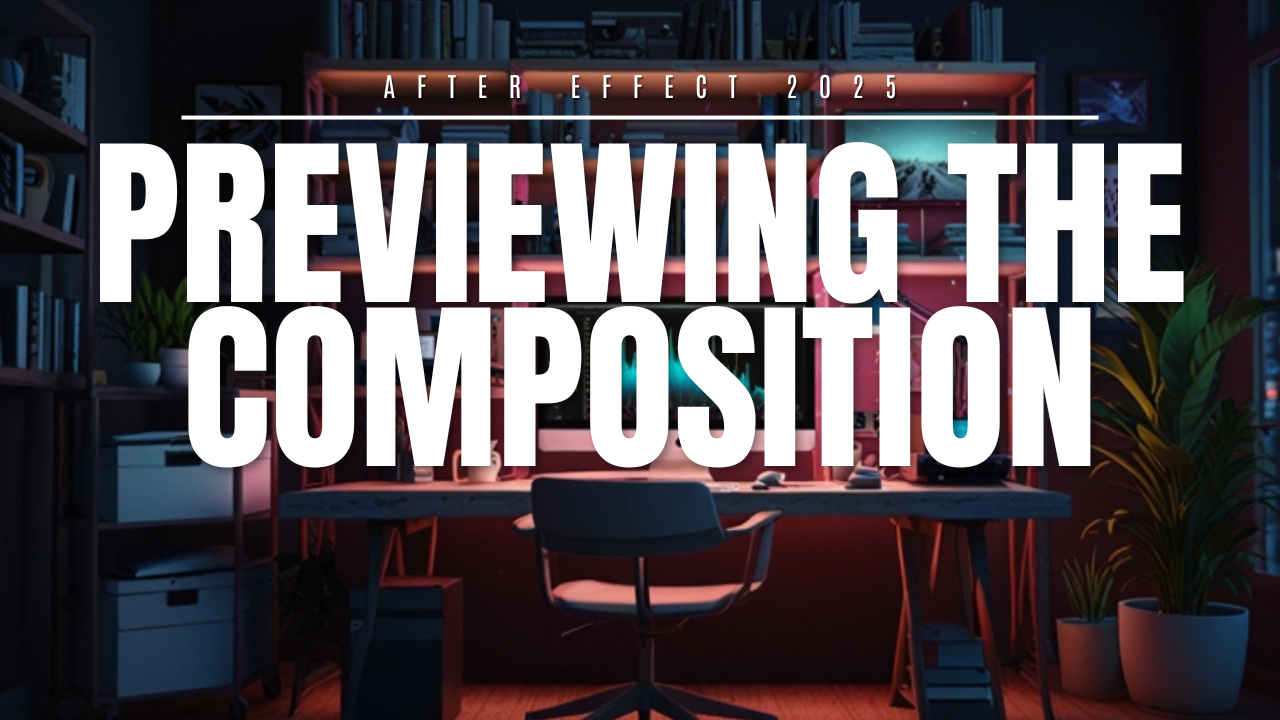
Created by - Anil Chauhan
Previewing the Composition
In Adobe After Effects, previewing and working with compositions are essential parts of the workflow, allowing you to visualize and refine your animations and effects. Here’s a breakdown:Previewing in After EffectsPreviewing allows you to see your animation and effects in real time, ensuring everything works as intended. RAM Preview: Purpose: Plays back your composition from the timeline with all effects and animations. How to Use: Press the spacebar or click the Preview button to start playback. Settings: Adjust the Resolution (Full, Half, Quarter) to speed up the preview. RAM Cache: After the first preview, After Effects stores frames in RAM to improve playback speed. Play In/Out Range: Set the In Point (B) and Out Point (N) on the timeline to define a section for previewing. Previewing a Range: Playback will only occur between these points. Spacebar Playback: Quickly play/pause the preview by pressing the spacebar. The playback quality can be adjusted in the Preview panel for smoother performance. Frame Rate: Preview at a lower frame rate for faster feedback, adjusting it in the Preview panel under Frame Rate options. Skip Frames: If your composition is too complex, you can enable Skip Frames (in the Preview panel), reducing the preview quality to improve performance. Audio Preview: If your composition includes audio, click the Audio checkbox in the Preview panel to include audio during previews. Region of Interest: Use the Region of Interest tool to preview a specific part of the composition, reducing the amount of RAM needed for playback. Working with CompositionsCompositions (or comps) are the containers where you create your final animations and visual effects by combining various layers. Creating a Composition: Go to Composition > New Composition or press Ctrl + N (Windows) / Cmd + N (Mac). Set the dimensions, frame rate, duration, and background color. Composition Settings: Resolution: Choose from Full, Half, or Quarter resolution to optimize performance. Frame Rate: Define the frame rate to match the project or desired output (e.g., 24 fps, 30 fps). Duration: Set the composition duration to define the timeline length. Multiple Compositions: You can create nested compositions (comps within comps) by pre-composing layers (Ctrl + Shift + C / Cmd + Shift + C). Helps organize complex projects and can simplify working with multiple elements. Work Area: The Work Area is the section of the timeline that determines what is rendered during previews. Adjust the Work Area Bar to focus on a specific part of the composition. Render Queue: Once you’re satisfied with your composition, send it to the Render Queue to export it. The Composition > Add to Render Queue option enables this. Preview Panel Controls Loop: Enable looping to continuously preview a section. Resolution: Set it to Full, Half, or Quarter for faster previews. Skip: Allows you to skip frames for faster preview rendering. Audio: Toggle to preview audio with the composition. Best Practices Optimize for Performance: Use lower resolution for previews to ensure smooth playback. Keep your compositions simple during the preview stage by hiding or disabling complex layers. Use RAM Preview for accurate playback with effects and animations. Monitor Memory Usage: If After Effects runs slow, clear the Disk Cache or RAM Cache to free up space. Use Proxies: For heavy assets like high-res videos, use proxies (lower resolution versions) during previews. Would you like further details or help setting up your preview and compositions in After Effects?
More detailsPublished - Wed, 22 Jan 2025
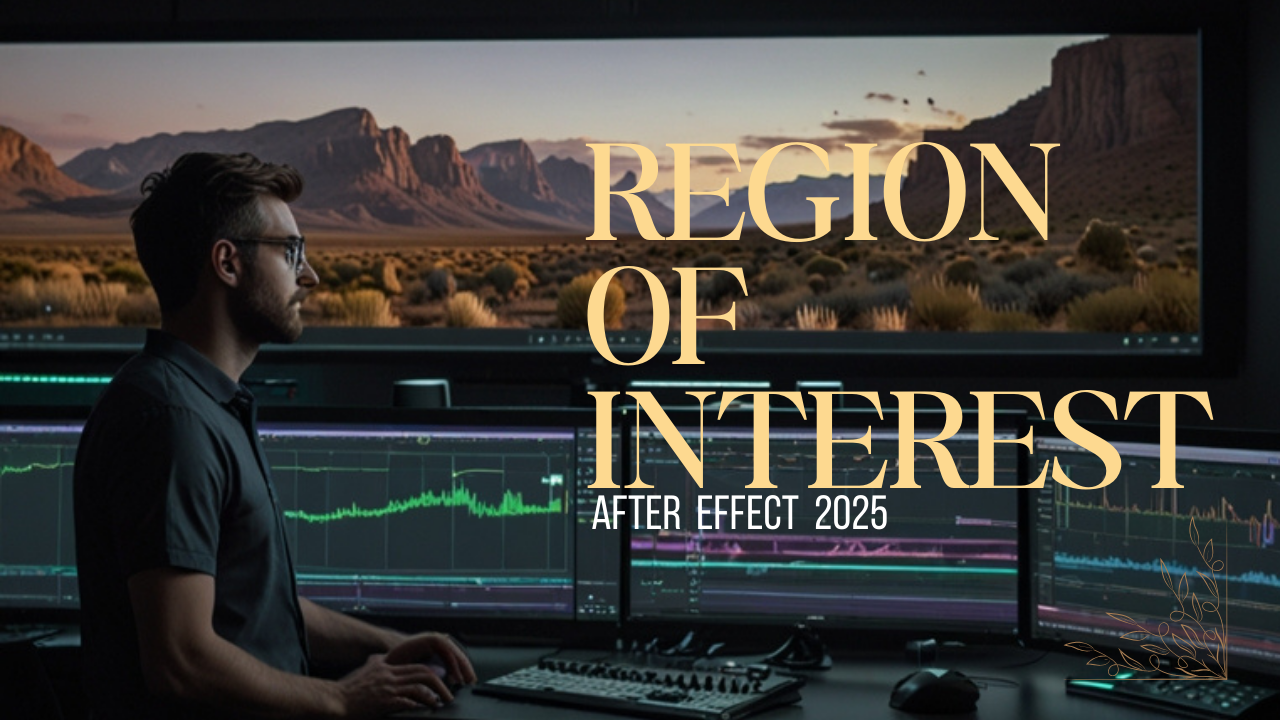
Created by - Anil Chauhan
Region of Interest
In Adobe After Effects, the Region of Interest (ROI) tool is a powerful feature that helps you focus on a specific area of your composition during previews or renders, improving performance by processing only the selected portion of the composition.Purpose of Region of Interest Performance Boost: When working with large compositions, using the ROI helps speed up previews by limiting playback to a smaller area. Focus on Key Elements: It allows you to focus on specific parts of a composition without rendering or previewing the entire frame. How to Use Region of Interest Activating ROI: Select the Region of Interest tool from the Composition panel. You can activate it by clicking the Region of Interest button (located below the composition viewer) or by pressing Ctrl + Alt + I (Windows) or Cmd + Option + I (Mac). Defining the Area: Drag to create a box around the area of the composition you want to preview. The selected area will be highlighted by a dashed border. Adjusting the Region: Resize or reposition the box by dragging the corners or edges. Previewing the Selected Area: Once the ROI is set, your previews will be limited to that region. This reduces the rendering load, especially in complex compositions. Key Points to Remember Preview Limitation: After setting a Region of Interest, After Effects will only render and preview the selected area. This can speed up rendering, especially for large, high-resolution files. Effects on Renders: When rendering, if the ROI is active, only the selected region will be outputted. This is useful for testing or rendering specific parts of a composition. Disabling ROI: To disable the ROI and render the full composition, uncheck the Region of Interest box or click the button again. Uses in Complex Projects: ROI is very useful for heavy compositions that contain lots of elements, animations, or effects that don't need to be rendered or previewed in their entirety. Best Practices Quick Previews: Use ROI when previewing a section of your composition for fine-tuning animation or effects. Optimize Performance: Especially with large compositions, ROI helps with managing system resources for faster rendering. Fine-Tuning Specific Areas: Perfect for refining animations or transitions in a specific part of the frame without waiting for a full composition render. Would you like further clarification or specific use cases for ROI?
More detailsPublished - Wed, 22 Jan 2025
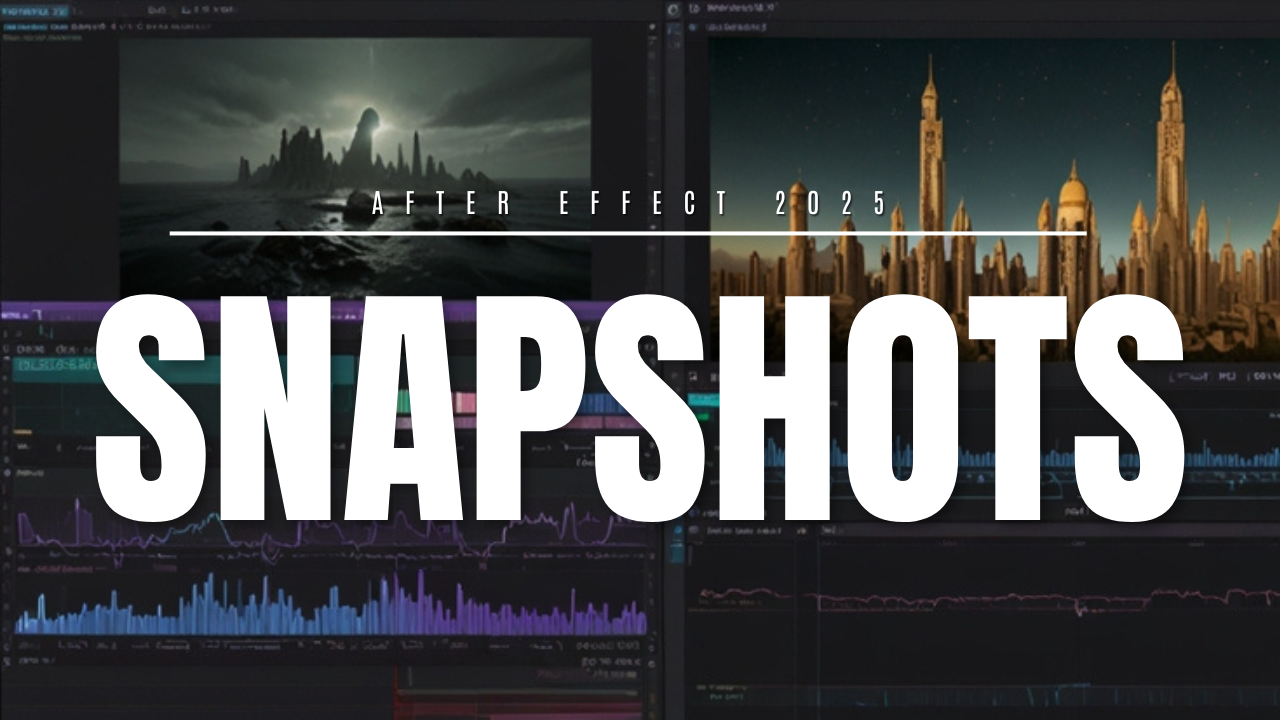
Created by - Anil Chauhan
Snapshots
In Adobe After Effects, snapshots refer to the ability to capture and save the state of a composition or a specific frame at a given time, so you can easily compare different stages of your project or revert to previous versions of your work.Purpose of Snapshots in After Effects Quick Comparisons: Snapshots allow you to compare different versions of your composition or specific frames within the same project. Non-Destructive Workflow: You can revert to a previous snapshot if needed, ensuring flexibility in your editing process. Track Changes: Snapshots help you track progress and visualize changes as you make adjustments to your layers, effects, and keyframes. How to Take a Snapshot Open the Snapshot Panel: Go to Window > Snapshot to open the Snapshot panel. Taking a Snapshot: While in the Composition or Layer panel, click the Take Snapshot button at the bottom of the panel (represented by a camera icon). This will capture the current view of the composition or the selected layer and store it in the Snapshot panel. Previewing Snapshots: After taking a snapshot, click on any snapshot in the Snapshot panel to preview it. You can view how your composition looked at the time the snapshot was taken. Clearing Snapshots: To clear a snapshot, simply click the Delete button in the Snapshot panel (trash can icon). Using Snapshots for Comparison Side-by-Side Comparison: You can open multiple snapshots and quickly compare different frames or versions of the composition to assess changes in animation or effects. Reverting to Previous States: If you’re not satisfied with changes made after taking a snapshot, you can return to that specific snapshot and continue working from that point. Best Practices Use Snapshots for Key Points: Take snapshots at key milestones or significant changes, like after applying a major effect or completing a portion of your animation. Keep Snapshots Organized: Label or number your snapshots to keep track of different versions or stages. Compare with New Changes: Use snapshots to compare your current progress with earlier states, helping you spot improvements or issues. Limit Snapshot Use: While snapshots are great for comparison, be mindful not to overload your project with too many saved versions to keep your workspace clean and organized. Would you like more detailed information about specific use cases for snapshots in After Effects?
More detailsPublished - Wed, 22 Jan 2025
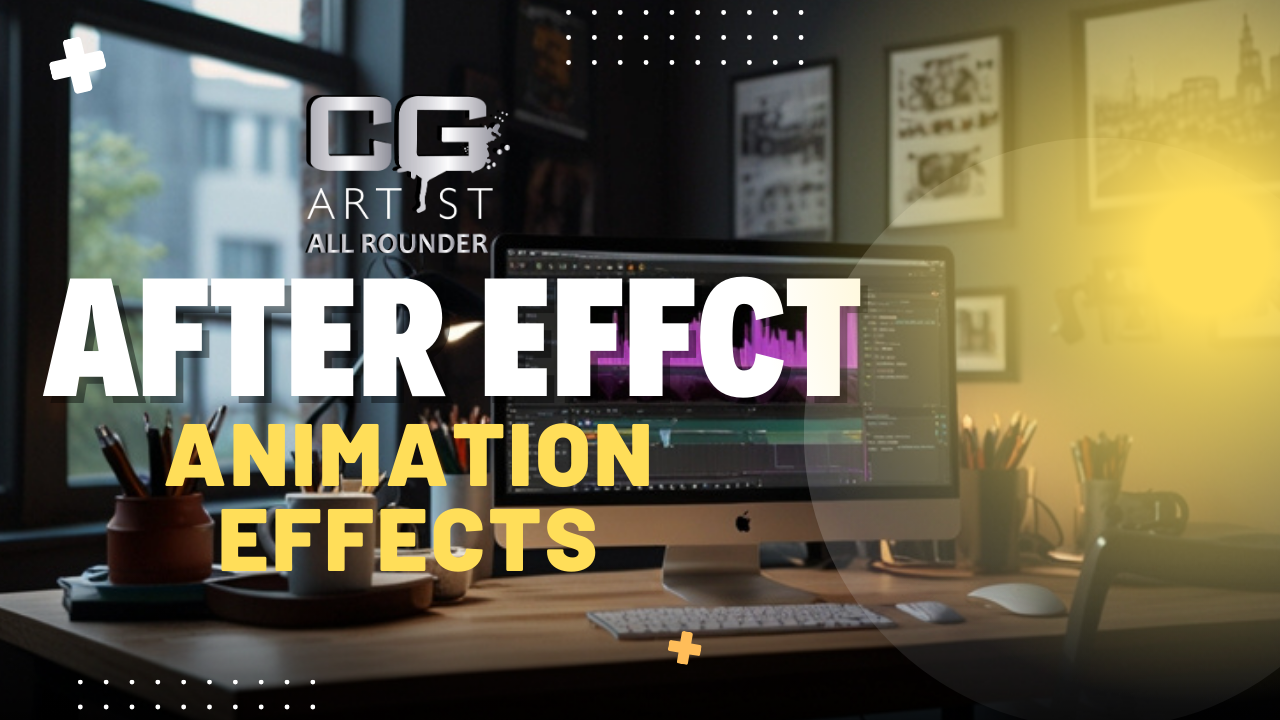
Created by - Anil Chauhan
After Effect - Creating Animation Effect
In Adobe After Effects, you can create animation effects using keyframes, presets, and expressions. Here’s a step-by-step guide:1. Basic Animation Using Keyframes???? Step 1: Import your assets (image, text, shape, etc.). ???? Step 2: Select a layer and go to the Timeline Panel. ???? Step 3: Expand Transform Properties (Position, Scale, Rotation, Opacity). ???? Step 4: Click the Stopwatch ⏱️ to set a keyframe at the start. ???? Step 5: Move the playhead forward and change the property (e.g., move position). ???? Step 6: AE will automatically interpolate the animation.2. Using Animation Presets???? Step 1: Open the Effects & Presets Panel. ???? Step 2: Search for animation presets (e.g., "Bounce," "Fade," "Zoom"). ???? Step 3: Drag and drop the preset onto a layer. ???? Step 4: Adjust keyframes if needed.3. Smooth Animation with Easing???? Select keyframes and press F9 for Easy Ease. ???? Open Graph Editor (Edit Speed for smooth motion).4. Advanced Animation Using Expressions???? Hold Alt + Click on a property’s stopwatch to add an expression. ???? Examples: Wiggle Effect (random movement): wiggle(3, 20) // Frequency: 3, Amplitude: 20 Looping Animation: loopOut("cycle") 5. Adding Motion Blur for Realism???? Enable Motion Blur in the Timeline Panel for smoother animations.6. Exporting Your Animation???? Go to File > Export > Add to Render Queue. ???? Choose H.264 (MP4) or GIF for final output. Basic Animation in After Effects ????✨Adobe After Effects lets you create animations using keyframes, effects, and expressions. Here’s a beginner-friendly guide:1. Setting Up an Animation???? Step 1: Create a New Composition (Ctrl + N). ???? Step 2: Import assets (File > Import > Select Files). ???? Step 3: Drag assets into the Timeline Panel.2. Keyframe Animation (Foundation of Motion)???? Select a layer and press P (Position), S (Scale), R (Rotation), or T (Opacity). ???? Click the Stopwatch ⏱️ to set a keyframe. ???? Move the playhead forward and adjust the value (AE auto-animates).✅ Example: Move text from left to right using Position keyframes.3. Easing for Smooth Motion???? Select keyframes → Press F9 (Easy Ease) for a natural feel. ???? Open Graph Editor to refine motion speed.4. Motion Blur for Realism???? Enable Motion Blur for smoother, natural motion. ???? Click the Motion Blur icon in the Timeline Panel.5. Using Presets for Quick Animations???? Go to Effects & Presets Panel → Search for animations like Bounce, Fade, Zoom. ???? Drag & drop onto layers.6. Expressions for Advanced Animation???? Hold Alt + Click on the Stopwatch to add code-based animations. ???? Example: Wiggle (random movement)wiggle(3, 20) // Moves 3 times per second, 20 pixels range 7. Exporting the Animation???? Go to File > Export > Add to Render Queue. ???? Select H.264 (MP4) or GIF for best results.???? Quick Tips:✅ Use Easy Ease (F9) for better movement. ✅ Enable Motion Blur for realistic motion. ✅ Experiment with Effects & Presets for cool animations. Keyframes & Expressions in After Effects ????✨In Adobe After Effects, keyframes and expressions are essential for creating animations.1. What are Keyframes? ⏱️Keyframes mark changes in a property over time to create animation.How to Use Keyframes: Select a layer in the Timeline. Press P (Position), S (Scale), R (Rotation), T (Opacity) to reveal properties. Click the Stopwatch ⏱️ to add a keyframe. Move the playhead and change the property value (AE auto-animates). ✅ Example: Move an object from left to right using Position keyframes.Types of Keyframes: Linear Keyframe: Default, creates a basic motion. Easy Ease (F9): Smooths motion for a more natural look. Bezier & Graph Editor: Custom easing for precise motion control. 2. What are Expressions? ????️Expressions use code to create animations without setting multiple keyframes.How to Use Expressions: Hold Alt + Click the Stopwatch on a property. A text field appears—enter an expression. Click away to apply. ✅ Example: Automatic Bouncing Motionamp = 20; // Amplitude (height) freq = 3; // Frequency (speed) decay = 2; // How fast it slows down n = time * freq; value + [0, amp * Math.sin(n) / Math.exp(n / decay)]; ???? This makes an object bounce naturally!3. Popular Expressions:Wiggle (Random Movement)wiggle(3, 20) // Moves 3 times per second, 20 pixels range ???? Great for flickering lights or shaky camera effects.Looping AnimationloopOut("cycle") // Repeats keyframes infinitely ???? Useful for looping rotations or blinking effects.Time-Based Rotationtime * 50 // Rotates 50 degrees per second ???? Great for rotating clock hands or propellers.4. When to Use Keyframes vs. Expressions? Feature Keyframes Expressions Manual control ✅ Yes ❌ No Smooth motion ✅ Yes ✅ Yes Automate animation ❌ No ✅ Yes Works without keyframes ❌ No ✅ Yes ???? Tip: Use keyframes for manual control and expressions for automation. Graph Editor in After Effects ????????The Graph Editor in Adobe After Effects gives you precise control over animation speed and motion curves. Instead of simple linear movements, you can smooth out animations and create natural motion.1. How to Open the Graph Editor????? Select your animated property (e.g., Position, Scale, Opacity). ???? Click the Graph Editor icon ???? in the Timeline (shortcut: Shift + F3).2. Types of Graphs in After EffectsThere are two types of graphs in AE’s Graph Editor:A. Value Graph ???? (Property Changes Over Time) Shows the exact values (e.g., position, scale). Helps create bouncing, overshoot, or elastic effects. B. Speed Graph ⚡ (Speed Over Time) Shows how fast an object moves between keyframes. Useful for smooth easing and acceleration effects. 3. Using the Graph Editor for Smoother AnimationA. Easy Ease (Smooth Start & Stop) Select keyframes → Press F9 (Easy Ease). Open Graph Editor. Drag the curve handles to smooth out motion. B. Custom Speed Adjustments Select the Speed Graph. Grab the handle before a keyframe → Pull left for a slow start. Grab the handle after a keyframe → Pull right for a smooth stop. C. Overshoot & Bounce Effects Use the Value Graph to create an "overshoot" motion (e.g., bouncing ball). Adjust handles for an elastic effect. 4. Tips for Using the Graph Editor Effectively✅ Use Speed Graph for smooth acceleration & deceleration. ✅ Use Value Graph for precise movement control. ✅ Adjust handles to create custom easing curves. ✅ Combine with expressions for dynamic motion (e.g., wiggle()).Graph Editor in After Effects ???????? The Graph Editor in Adobe After Effects gives you precise control over animation speed and motion curves. Instead of simple linear movements, you can smooth out animations and create natural motion. 1. How to Open the Graph Editor? ???? Select your animated property (e.g., Position, Scale, Opacity). ???? Click the Graph Editor icon ???? in the Timeline (shortcut: Shift + F3). 2. Types of Graphs in After Effects There are two types of graphs in AE’s Graph Editor: A. Value Graph ???? (Property Changes Over Time) Shows the exact values (e.g., position, scale). Helps create bouncing, overshoot, or elastic effects. B. Speed Graph ⚡ (Speed Over Time) Shows how fast an object moves between keyframes. Useful for smooth easing and acceleration effects. 3. Using the Graph Editor for Smoother Animation A. Easy Ease (Smooth Start & Stop) Select keyframes → Press F9 (Easy Ease). Open Graph Editor. Drag the curve handles to smooth out motion. B. Custom Speed Adjustments Select the Speed Graph. Grab the handle before a keyframe → Pull left for a slow start. Grab the handle after a keyframe → Pull right for a smooth stop. C. Overshoot & Bounce Effects Use the Value Graph to create an "overshoot" motion (e.g., bouncing ball). Adjust handles for an elastic effect. 4. Tips for Using the Graph Editor Effectively ✅ Use Speed Graph for smooth acceleration & deceleration. ✅ Use Value Graph for precise movement control. ✅ Adjust handles to create custom easing curves. ✅ Combine with expressions for dynamic motion (e.g., wiggle()). ???? Want help with a specific effect in the Graph Editor? Let me know! ????
More detailsPublished - 6 Days Ago
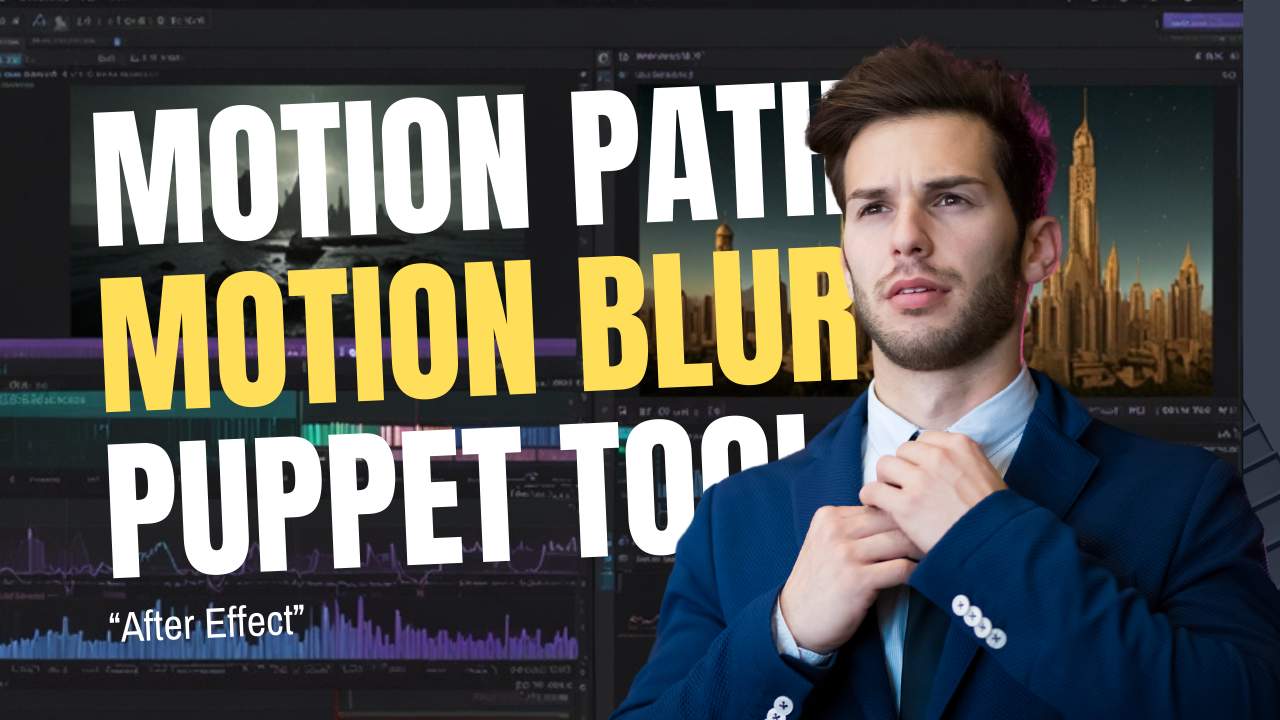
Created by - Anil Chauhan
Motion Path,Motion Blur and Puppet Tools
In Adobe After Effects, a motion path is the trajectory an object follows over time when animated with position keyframes. Here’s how to work with motion paths effectively:1. Creating a Motion Path Select a layer (e.g., a shape, text, or image). Press P to reveal the Position property. Click the stopwatch icon next to Position to create the first keyframe. Move the playhead forward in the timeline. Move the object to a new location → This automatically creates a second keyframe. The object will now follow the path between the keyframes. 2. Editing a Motion Path After adding position keyframes, a motion path appears in the composition. Select the layer and use the Selection Tool (V) to adjust the curve by dragging points. If you want a smooth curved path, right-click a keyframe → Keyframe Interpolation → Change to Bezier. Use the Pen Tool (G) to adjust handles and refine the path. 3. Creating a Custom Path with the Pen Tool Use the Pen Tool (G) to draw a shape or path. Copy (Ctrl/Cmd + C) the path from the Shape Layer’s Path property. Select the Position property of another layer and paste (Ctrl/Cmd + V) → The object follows the path. 4. Adjusting Motion Path Speed Use the Graph Editor (Shift + F3) to adjust the speed for a more natural motion. Right-click a keyframe → Easy Ease (F9) for smooth acceleration and deceleration. Drag the speed curve handles to control motion dynamics. 5. Parenting to a Motion Path Use the Null Object technique: Create a Null Object (Layer > New > Null Object). Animate the Null Object’s position along the desired path. Parent other layers to the Null using the Pick Whip. 6. RotoBezier for Smoother Curves Select the motion path → Right-click keyframe → RotoBezier for automatic smooth curves. Motion Blur in After EffectsMotion blur makes moving objects appear more natural by simulating the blur effect seen in real-world motion. It helps add realism to animations, especially for fast-moving objects.1. Enabling Motion Blur for a Layer Locate the Timeline Panel. Find the Motion Blur Toggle (three overlapping circles) at the top of the layer panel. Enable Motion Blur for your desired layers by clicking the checkbox under the Motion Blur column. Activate Motion Blur for the entire composition by clicking the Master Switch (same three-circle icon at the top of the layer stack). 2. Adjusting Motion Blur SettingsFor more control over the blur effect: Go to Composition > Composition Settings > Advanced tab. Adjust: Shutter Angle (default is 180°; increasing it creates more blur). Shutter Phase (controls blur offset relative to movement). Samples Per Frame (higher values result in smoother blur but increase render time). 3. Using Motion Blur with Effects Some effects (e.g., Transform Effect) do not inherit motion blur automatically. To force motion blur, use the CC Force Motion Blur effect: Select the layer. Go to Effect > Time > CC Force Motion Blur. Adjust Motion Blur Samples for smoother results. 4. Alternative: RSMB (ReelSmart Motion Blur) If you need more advanced blur, the ReelSmart Motion Blur (RSMB) plugin can generate blur from motion vectors, even if no actual movement occurs in the animation. 5. Motion Blur for 3D Layers Motion blur works for 2D and 3D layers. For 3D layers, ensure that the Camera Settings also have a proper Shutter Angle. When to Use Motion Blur✅ Fast-moving objects (text, shapes, particles, etc.) ✅ Camera movements (panning, zooming, rotation, etc.) ✅ Character animation for smoother motion ✅ Creating a cinematic feel Animating with Puppet Tools in After Effects ????????The Puppet Tool in Adobe After Effects allows you to animate still images, shapes, or characters by creating deformable joints. It’s perfect for character animation, organic motion, or adding subtle movements to objects.1. Setting Up the Puppet Tool Import or Create Your Layer Works best with PNG images with transparency, shape layers, or solid layers. If using an image, convert it to a Rasterized Layer (Layer > Auto-Traced for vector images). Select the Puppet Tool Choose the Puppet Pin Tool (Ctrl + P / Cmd + P). Click on your object to place pins (like joints). 2. Types of Puppet Tools???? Puppet Pin Tool (Default) – Places basic deformation points. ???? Puppet Starch Tool – Prevents unwanted deformation (adds rigidity). ???? Puppet Overlap Tool – Controls depth (which part appears in front). ???? Puppet Advanced Pin Tool – Adds rotation, scale, and bend controls.3. Animating with Puppet Pins Set Keyframes After placing pins, go to the Timeline Panel. Open the layer’s “Effects” > Puppet > Mesh > Deform to see all pins. Move the playhead to a new time position and drag a pin → AE automatically creates keyframes. Refine the Motion Adjust the keyframes in the Graph Editor for smoother movement. Use Easy Ease (F9) for a more natural feel. 4. Advanced Puppet Tool (Newer AE Versions)New versions of After Effects introduce Puppet Engine Options: Legacy (Old method, good for simple animation). Advanced (Better deformation control). Rigid (Maintains shape better). To change this: ???? Go to Mesh Options → Select the preferred Puppet Engine.5. Adding Secondary MotionFor realistic movement, try: ✅ Overlap & Follow-through: Add extra keyframes for delayed limb movements (e.g., hair sways after the head moves). ✅ Squash & Stretch: Slightly scale/stretch elements for cartoony motion. ✅ Parental Rigging: Parent parts (e.g., hands to arms) to create linked movement. Extra Tip: Rigging with Duik for Advanced ControlIf you need bone-based rigging (for characters), try the free Duik Bassel plugin for more advanced animation controls.When to Use Puppet Tool?✅ Animating characters or creatures ✅ Making objects "breathe" or wiggle ✅ Giving life to still images ✅ Subtle organic motion in graphics Would you like help with a specific puppet animation style? ????
More detailsPublished - 3 Days Ago
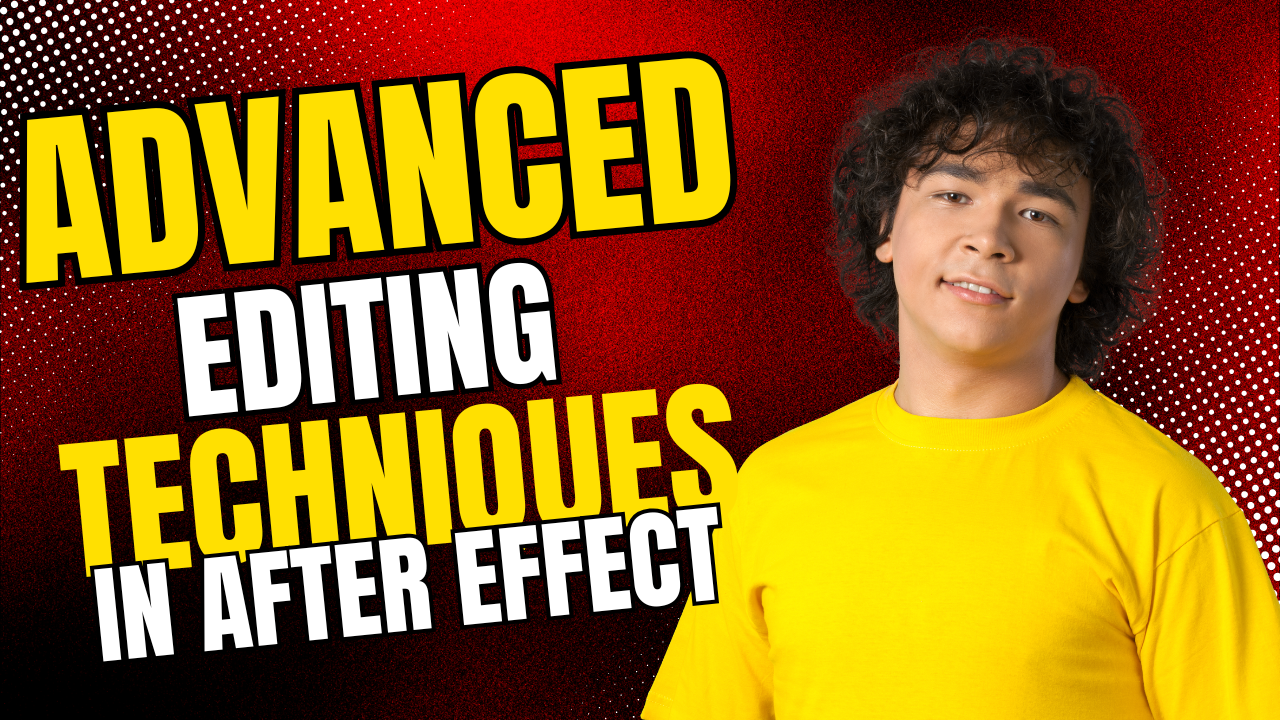
Created by - Anil Chauhan
Advanced Editing Techniques in After Effects
Advanced Editing Techniques in After Effects ????If you want to take your After Effects skills to the next level, here are some advanced editing techniques to enhance your motion graphics, VFX, and compositing.1. Advanced Keyframing & Animation???? Graph Editor for Smooth Animation Use the Graph Editor (Shift + F3) to fine-tune speed and motion. Adjust Speed Graph and Value Graph for natural easing. Apply Easy Ease (F9) or manually adjust curves for smooth movement. ???? Expressions for Automation Add expressions by holding Alt (Win) / Option (Mac) + Clicking a Stopwatch. Common expressions: Wiggle (random motion): wiggle(3,50) (3 times per second, 50-pixel variation) Looping animation: loopOut("cycle") (Repeats animation infinitely) Time-based animation: time*50 (Moves automatically over time) 2. Masking & Rotoscoping???? Advanced Masking Use Bezier Handles for precise mask control. Feather masks for smoother edges (F key to adjust). Apply Track Matte for creative transparency effects. ???? Rotoscoping with Roto Brush Select a layer and use Roto Brush Tool (Alt/Option + W). Refine edges in the Refine Edge Matte panel. Freeze roto when satisfied to avoid re-tracking. 3. Motion Tracking & Stabilization???? 2D Motion Tracking Use Tracker Panel → Track motion → Attach Null Object. Parent text or graphics to the Null Object for realistic movement. ???? 3D Camera Tracking Effect > Perspective > 3D Camera Tracker. After analysis, select a point and create Text or Solid. Great for placing objects in real-world footage. ???? Warp Stabilizer Effect > Distort > Warp Stabilizer to smooth shaky footage. Adjust Smoothness (10–30%) for natural results. 4. 3D Animation & Camera Work???? Creating a 3D Scene Toggle the 3D Layer Switch (cube icon) on your layers. Adjust X, Y, Z rotation for depth. Use Depth of Field for cinematic blur. ???? Advanced Camera Controls Create a Camera Layer (Layer > New > Camera). Use a Null Object to control the camera easily. Enable Orbit, Track XY, and Zoom tools for dynamic movement. 5. Advanced Effects & Compositing???? Displacement Mapping Effect > Distort > Displacement Map to create glitch and ripple effects. Use a grayscale map to control distortion strength. ???? Parallax & Depth Effects Use multiple layers in 3D space to create depth. Animate the Camera Position for a parallax effect. ???? Light and Shadows in 3D Create a Light Layer (Layer > New > Light). Adjust Layer Material Options to cast shadows and interact with light. 6. Time Manipulation Techniques???? Speed Ramping with Time Remapping Right-click the layer → Enable Time Remapping. Add keyframes and adjust speed in Graph Editor. ???? Frame Blending for Smooth Motion Click the Frame Blending Toggle (wave-like icon). Use Pixel Motion for smooth interpolation. ???? Time Freeze & Reverse Effect > Time > Time Freeze to pause motion. Use Time-Reverse Keyframes to play footage backward. 7. Green Screen & Keying???? Keying Out Green Screens Effect > Keying > Keylight (1.2). Select the green color with the Eyedropper tool. Adjust Screen Gain and Clip Black/White for a clean key. Add a Spill Suppressor to remove green edges. 8. Advanced Color Grading & Glow Effects???? Color Correction Use Lumetri Color for cinematic grading. Adjust Curves, Exposure, and Vibrance for rich colors. ???? Glow & Light Effects Effect > Stylize > Glow for soft light effects. Use Optical Flares (Video Copilot plugin) for realistic lens flares. 9. Advanced Rendering & Optimization???? Optimize Performance Use Proxies (Right-click > Create Proxy) for smooth playback. Enable Fast Draft Mode in the preview panel. Purge memory (Edit > Purge > All Memory & Disk Cache). ???? Best Render Settings Use Adobe Media Encoder for better compression. Export with H.264 (MP4) at 10-20 Mbps for web use. Use ProRes or Cineform for high-quality exports. ???? Bonus: Must-Know Plugins for Advanced Editing✅ Element 3D (Video Copilot) – For advanced 3D graphics ✅ Red Giant Trapcode Suite – For particle effects ✅ ReelSmart Motion Blur (RSMB) – Advanced motion blur ✅ Deep Glow – High-quality glow effect ✅ Saber (Free Plugin by Video Copilot) – Light and energy effects Motion Stabilization in After Effects ???????? Motion stabilization helps smooth out shaky footage and create a more polished look. After Effects offers powerful tools for stabilizing video, including Warp Stabilizer and Point Tracking Stabilization. 1. Using Warp Stabilizer (Quick & Automatic) The Warp Stabilizer is the easiest way to remove camera shake. Steps: 1️⃣ Select your shaky footage in the Timeline. 2️⃣ Go to Effect > Distort > Warp Stabilizer. 3️⃣ The effect will automatically analyze your footage. 4️⃣ Adjust Stabilization Settings (see below for best settings). Best Warp Stabilizer Settings: Result: Smooth Motion (if you want to retain camera movement) OR No Motion (for a locked-off look). Smoothness: Start with 50% (lower if too much distortion). Method: Try Position, Scale, Rotation first. If still shaky, switch to Subspace Warp. Crop Less, Smooth More: Adjust this slider for better results. Advanced > Rolling Shutter Reduction: Helps with distortion from DSLRs or smartphones. ⚠️ Pro Tip: If you notice a wobbly or jelly effect, lower the Smoothness or change the Method to "Position, Scale, and Rotation." 2. Stabilizing with Motion Tracking (Manual Control) For more control, you can use Point Tracking to stabilize a specific part of your footage. Steps: 1️⃣ Select your video layer. 2️⃣ Open the Tracker Panel (Window > Tracker). 3️⃣ Click Track Motion and check Position (and optionally, Rotation & Scale). 4️⃣ Place the tracking point on a high-contrast feature (e.g., a window corner, road sign). 5️⃣ Click Analyze Forward ▶ to track motion. 6️⃣ Click Edit Target → Choose the same video layer → Apply (X and Y). 7️⃣ Enable Motion Stabilization by inverting the movement of the tracked points. Pros: ✔️ More control than Warp Stabilizer. ✔️ Works well for locked shots (e.g., talking head footage). Cons: ❌ Doesn't work well for complex shakes or rolling shutter issues. 3. Advanced Stabilization: Combining Both Methods Sometimes, Warp Stabilizer alone doesn’t work perfectly. In such cases: First, apply Motion Tracking Stabilization. Then, apply Warp Stabilizer for finer smoothing. ???? Tip: Pre-compose (Ctrl + Shift + C) your stabilized layer before applying Warp Stabilizer to avoid errors. 4. When to Use Motion Stabilization? ✅ Handheld footage that needs smoothing. ✅ Footage shot without a tripod or gimbal. ✅ Tracking a specific object while keeping it stable. ✅ Reducing motion sickness effects in videos. Need help stabilizing a specific type of footage? Let me know! ????✨Motion Tracking in After Effects ???????? Motion Tracking allows you to attach graphics, text, or effects to moving objects in your footage. It’s widely used for object tracking, screen replacements, and stabilizing shaky footage. 1. Types of Motion Tracking in After Effects ???? Single-Point Tracking – Tracks one point for basic motion. ???? Two-Point Tracking – Tracks position, rotation, and scale. ???? Planar Tracking (Corner Pin Tracking) – Used for screen replacements. ???? 3D Camera Tracking – Used for integrating 3D elements into live footage. 2. Single-Point Motion Tracking (Basic Tracking) Used for attaching objects to a moving subject. Steps: 1️⃣ Import your footage and place it in the timeline. 2️⃣ Select the video layer and open the Tracker Panel (Window > Tracker). 3️⃣ Click Track Motion → Enable Position (default). 4️⃣ In the Layer Panel, place the tracker box over a high-contrast area (e.g., a logo, object, or face). 5️⃣ Click Analyze Forward ▶ to track motion. 6️⃣ Click Edit Target → Select the layer to apply tracking. 7️⃣ Click Apply (choose X & Y). 8️⃣ The object or text will now follow the tracked motion! Pro Tip: ✔️ Use Adjust Track if tracking drifts off. ✔️ Increase the search region if the track fails. 3. Two-Point Motion Tracking (Position, Scale & Rotation) Used when objects change size or rotate (e.g., tracking a moving billboard). Steps: 1️⃣ Follow the Single-Point Tracking Steps above. 2️⃣ Enable Rotation & Scale in the Tracker Panel. 3️⃣ Place two tracking points on opposite sides of the object. 4️⃣ Track the motion and apply it to a Null Object. 5️⃣ Parent your graphic or text to the Null Object for smooth tracking. 4. Corner Pin Tracking (Planar Tracking) Used for screen replacements (e.g., adding a new image on a phone or TV screen). Steps: 1️⃣ Select your footage and open the Tracker Panel. 2️⃣ Click Track Motion → Enable Perspective (Corner Pin). 3️⃣ Adjust the four tracking points to match the corners of the screen. 4️⃣ Track the motion and apply it to your replacement layer. 5️⃣ Use Effect > Distort > Corner Pin to fine-tune placement. Pro Tip: If tracking fails, use Mocha AE (Effect > Boris FX Mocha) for better planar tracking. 5. 3D Camera Tracking (Adding 3D Text or Objects) Used for tracking movement in a 3D scene to integrate text, graphics, or 3D objects. Steps: 1️⃣ Select the footage and go to Effect > Perspective > 3D Camera Tracker. 2️⃣ Wait for analysis (check the status in the Effects panel). 3️⃣ Click on a tracked point (small colored dots will appear). 4️⃣ Right-click → Create Text and Camera (or Solid/Null for other elements). 5️⃣ Adjust the text or object to match the perspective. Pro Tip: ✔️ Works best with stable footage (avoid extreme motion blur). ✔️ Use Shadows & Lights for realistic 3D integration. 6. Motion Tracking with Expressions For automated tracking effects, use expressions: Attach an object to a tracked Null with: thisComp.layer("Null 1").position Use wiggle() for shaky effects: wiggle(3,10) (shakes 3 times per second by 10 pixels) 7. When to Use Motion Tracking? ✅ Attaching text/logos to moving objects. ✅ Replacing screens (phones, TVs, billboards). ✅ Stabilizing handheld shots. ✅ Adding 3D objects into real-world scenes. ✅ Creating VFX (e.g., HUD displays, holograms, and light effects). Need help with a specific tracking effect? Let me know! ????????Face Tracking in After Effects ???????? Face Tracking in After Effects allows you to track facial features and apply effects like face replacement, digital makeup, expressions tracking, and more. 1. Types of Face Tracking in After Effects ???? Basic Face Tracking (Outline Only) – Tracks face movement without detailed facial features. ???? Detailed Face Tracking (Feature Points) – Tracks eyes, nose, mouth, chin, and brows for advanced effects like face distortion or motion capture. 2. How to Use Face Tracking in After Effects???? Basic Face Tracking (Outline Tracking) Used to track a person's face movement (e.g., attaching objects like masks or effects). Steps: 1️⃣ Import your video and select the face layer. 2️⃣ Open the Tracker Panel (Window > Tracker). 3️⃣ Click "Track Face". 4️⃣ Choose "Face Tracking (Outline Only)". 5️⃣ Click "Analyze Forward ▶" to track the face movement. 6️⃣ Once tracking is complete, you can attach effects (e.g., a mask, text, or motion graphics). ✅ Best for: Applying effects to an entire face (like motion blur, color correction, or masks). ???? Detailed Face Tracking (Feature Points) Used to track facial features (eyes, nose, mouth, etc.) for more advanced effects like motion capture, face distortion, or expressions tracking. Steps: 1️⃣ Follow steps 1–4 from Basic Face Tracking. 2️⃣ Select "Face Tracking (Detailed Features)" instead. 3️⃣ Click "Analyze Forward ▶" to track all face features. 4️⃣ After tracking, you can see the face feature points in the layer properties (Effects > Face Tracking). ✅ Best for: ✔️ Applying eyewear, masks, or face paint. ✔️ Using motion capture for facial expressions. ✔️ Lip-sync animation for character animation. 3. Using Face Tracking for Effects???? Attaching Graphics or Text to a Face Create a Null Object (Layer > New > Null Object). Use Edit Target to apply the tracking data to the Null Object. Parent text, glasses, or effects to the Null Object (Pick Whip Tool). ???? Face Replacement (Deep Fake Style) Track the face using Detailed Face Tracking. Import a replacement face (PNG or another face video). Use Corner Pin or Mesh Warp (Effect > Distort > Mesh Warp) to fit the replacement face onto the tracked face. ???? Adding Digital Makeup Create a solid layer and mask areas (e.g., lips, eyes). Parent the masked layer to the face tracking data. Adjust opacity/blending modes for a natural effect. 4. When to Use Face Tracking? ✅ Adding glasses, masks, or face filters. ✅ Creating character animation using real facial expressions. ✅ Applying digital makeup or beauty retouching. ✅ Enhancing VFX for movies or ads. Need help with a specific face tracking effect? Let me know! ????????3D Camera Tracker in After Effects ???????? The 3D Camera Tracker allows you to analyze footage and extract camera movement, enabling you to place 3D objects, text, and effects into live-action scenes. This is useful for match-moving, set extensions, adding VFX, and compositing 3D elements. 1. How the 3D Camera Tracker Works The 3D Camera Tracker analyzes motion in the scene and reconstructs a virtual 3D camera, allowing you to place elements that move realistically with the footage. 2. How to Use 3D Camera Tracker???? Step-by-Step Guide 1️⃣ Import your footage and place it in the timeline. 2️⃣ Select the footage layer, then go to: Effect > Perspective > 3D Camera Tracker. 3️⃣ Wait for the Analysis Phase (this may take some time). The tracker will analyze motion and detect tracking points. 4️⃣ After analysis, hover over the footage to see tracking points. A red, yellow, or green target will appear, showing the plane where objects can be placed. 5️⃣ Select multiple tracking points that align with your desired surface. 6️⃣ Right-click and choose: ???? "Create Text and Camera" → Adds 3D text that matches the scene. ???? "Create Solid and Camera" → Adds a 3D plane for reference. ???? "Create Null and Camera" → Adds a tracking point for other objects. 7️⃣ Adjust the 3D object (scale, position, and rotation) to match the scene. ✅ Done! Your text or object will now move with the camera in 3D space. 3. Best Settings for 3D Camera Tracker???? Troubleshooting Tips ???? Tracking not working? → Make sure your footage is stable and has enough detail. ???? Points are jumping around? → Use "Detailed Analysis" in the effect settings. ???? No Trackable Features? → Use "Track Motion" instead for 2D tracking. ???? Camera Tracker Settings Shot Type: Auto-Detect Solve Method: Typical Track Points Size: Increase if needed for better visibility. Create Nulls or Solids: Helps in positioning objects precisely. 4. Creative Uses of 3D Camera Tracking ✅ Placing 3D text into live footage (text follows camera movement). ✅ Inserting digital billboards or posters into scenes. ✅ Adding objects like explosions, dust, or debris realistically. ✅ Reconstructing 3D environments for VFX. ✅ Set extensions (adding buildings, skies, or CGI elements). Need help with a specific effect? Let me know! ????????
More detailsPublished - 3 Days Ago
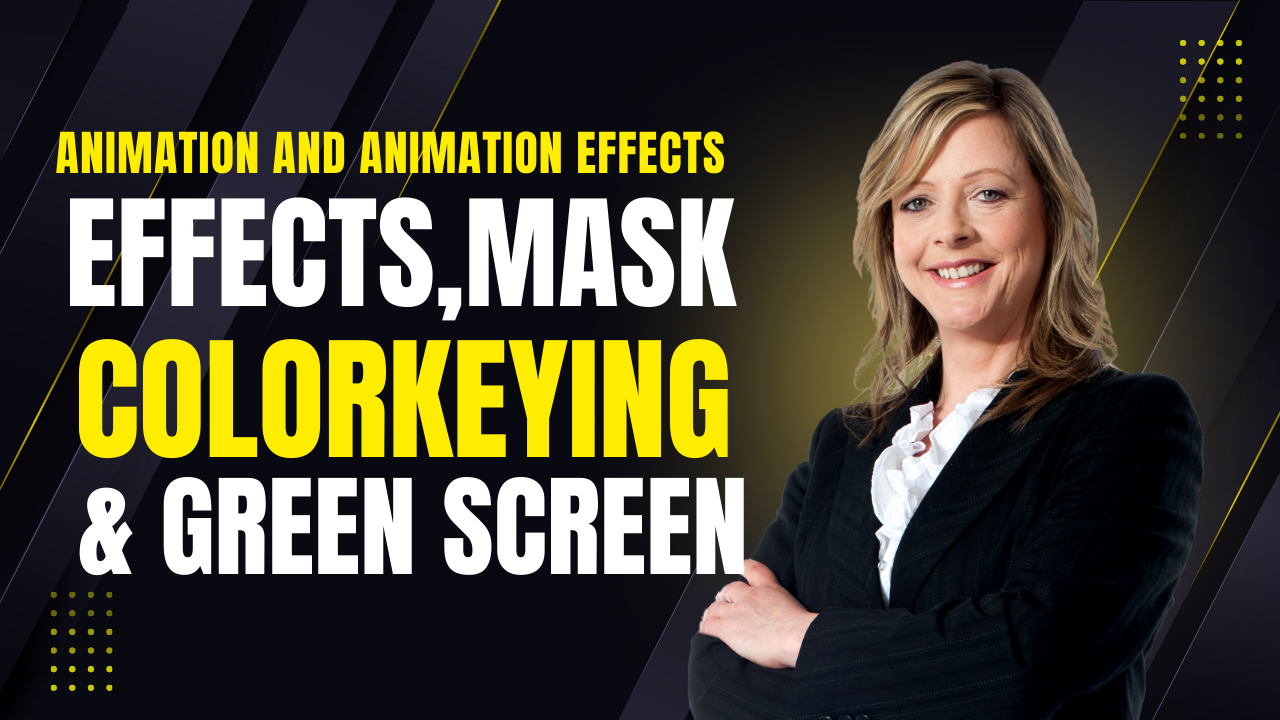
Created by - Anil Chauhan
Applying Effects Using Presets in After Effects
Applying Effects Using Presets in After Effects ????⚡Presets in After Effects allow you to quickly add animations, transitions, and effects to your layers without manually keyframing everything. These are great for text animation, motion graphics, color effects, and more!1. How to Apply Presets in After Effects???? Method 1: Using the Effects & Presets Panel1️⃣ Open After Effects and import your footage or text layer. 2️⃣ Go to the Effects & Presets panel (Window > Effects & Presets). 3️⃣ Search for a preset (e.g., "Fade In" or "Bounce"). 4️⃣ Drag and drop the preset onto your text, shape, or footage layer.???? Method 2: Using Animation Presets (Pre-Saved Effects)1️⃣ Open the Effects & Presets Panel. 2️⃣ Click on the "Animation Presets" folder. 3️⃣ Browse categories like: Text (e.g., Typewriter, Fade Up, 3D Spin) Transitions (e.g., Dissolves, Wipes) Behaviors (e.g., Wiggle, Float) 4️⃣ Drag a preset onto your layer to apply the effect. 2. Using Pre-Installed Animation Presets???? Text Animation Presets1️⃣ Select your Text Layer. 2️⃣ Open Effects & Presets → Animation Presets → Text. 3️⃣ Drag effects like Typewriter, Bounce, Fade, or 3D Rotate onto your text. 4️⃣ Adjust keyframes in the Timeline for speed control.✅ Popular Text Presets: Typewriter – Simulates typing letters one by one. Bounce In/Out – Makes text pop dynamically. Slide In/Out – Moves text smoothly into the frame. Blurred Reveal – Text appears with a blur effect. ???? Transition & Effects Presets1️⃣ Select your footage or shape layer. 2️⃣ Open Effects & Presets → Animation Presets → Transitions. 3️⃣ Apply effects like Fade In/Out, Wipe, or Zoom Blur.✅ Popular Transition Presets: Cross Dissolve – Smooth fade between clips. Zoom In/Out – Creates a cinematic zoom effect. Light Leaks – Adds a glowing film effect. Glitch – Creates a digital distortion look. 3. Saving & Importing Custom Presets???? How to Save Your Own Preset1️⃣ Apply effects and keyframes to your layer. 2️⃣ Select the modified effect(s) in the Effects Control Panel. 3️⃣ Go to Animation > Save Animation Preset. 4️⃣ Choose a location (Documents > Adobe > After Effects > User Presets). 5️⃣ Now, you can reuse it by searching in Effects & Presets.???? How to Import External Presets1️⃣ Download .ffx preset files. 2️⃣ Move them to: Documents > Adobe > After Effects > User Presets. 3️⃣ Restart After Effects and find them in the Effects & Presets Panel.4. When to Use Presets?✅ To speed up animation workflows. ✅ For quick text and transition effects. ✅ To maintain consistency in motion graphics. ✅ When you need professional results without manual keyframes. Need help finding a specific preset? Let me know! ????????Masks in After Effects ????✂️ Masks in After Effects allow you to selectively reveal or hide parts of a layer, create custom transitions, and add creative effects like shape reveals, cutouts, and animations. 1. How to Create a Mask???? Using Shape Tools (Ellipse, Rectangle, etc.) 1️⃣ Select your layer (video, text, or solid). 2️⃣ Choose a Shape Tool (Q for quick access). Ellipse (O), Rectangle (R), Polygon, etc. 3️⃣ Click and drag on the layer to create a mask. 4️⃣ The mask will cut out the selected area, making the rest invisible. ✅ Pro Tip: Hold Shift while dragging for a perfect circle or square. ???? Using the Pen Tool (Custom Shape Mask) 1️⃣ Select your layer. 2️⃣ Choose the Pen Tool (G). 3️⃣ Click points to draw a custom shape around the object. 4️⃣ Close the shape to complete the mask. ✅ Best for: Cutting out objects, creating complex shapes, or tracing edges. 2. Adjusting Mask Properties After creating a mask, open the Mask settings (M shortcut) under the layer. ???? Key Mask Settings: Mask Path – Edit the shape over time for mask animation. Mask Feather – Softens the edges (great for blending). Mask Opacity – Adjusts transparency. Mask Expansion – Expands or contracts the mask boundary. Mode (Add/Subtract/Intersect) – Controls mask visibility. ✅ Pro Tip: Press F to quickly adjust feathering. 3. Animating Masks (Mask Path) To animate a mask over time (e.g., for a revealing effect): 1️⃣ Select your Mask Path in the timeline. 2️⃣ Click the Stopwatch ⏱️ to enable keyframes. 3️⃣ Move the playhead and adjust the mask shape. 4️⃣ Repeat for smooth animation. ✅ Best for: Shape reveals, face tracking, or animated cutouts. 4. Track Mattes & Masks Instead of manually animating masks, you can use Track Mattes: Alpha Matte: Uses the shape of one layer to mask another. Luma Matte: Uses brightness values for masking. ???? How to Use a Track Matte 1️⃣ Place a mask layer (e.g., a shape) above your main layer. 2️⃣ In the TrkMat (Track Matte) dropdown, select: Alpha Matte (for shape-based masking). Luma Matte (for brightness-based masking). ✅ Best for: Text reveals, transitions, and creative cutouts. 5. Masking for Special Effects ✅ Face Blur (Censoring) → Create a mask & apply Gaussian Blur. ✅ Text Reveal (Handwriting Effect) → Animate a mask over text. ✅ Vignette Effect → Use a feathered ellipse mask for dark edges. ✅ Custom Transitions → Animate shapes to create smooth scene transitions. Need help with a specific masking effect? Let me know! ????✨Color Keying in After Effects ????✨ Color Keying is a powerful technique used to remove or replace specific colors in a video. It's commonly used for green screen effects or background removal. After Effects offers several tools for color keying, including Keylight, Color Range, and Color Key. 1. Keylight (Best for Green Screen Keying) Keylight is one of the most powerful and accurate keying tools available in After Effects. It’s ideal for removing a specific color (like green or blue) and replacing it with a new background. Steps for Using Keylight: 1️⃣ Select your video layer with the green screen or chroma key background. 2️⃣ Go to Effect > Keying > Keylight (1.2). 3️⃣ In the Effect Controls panel, use the Eyedropper tool to select the background color (e.g., green). 4️⃣ Adjust the Screen Gain and Screen Balance to fine-tune the key. 5️⃣ Use Screen Matte options (Clip Black and Clip White) to clean up edges. 6️⃣ Enable Despill Bias to remove any green or blue color spill on your subject. 2. Color Key (Simple Keying Tool) Color Key is a simpler tool for removing solid colors from your footage. It’s often used for more straightforward color removal (like isolating specific elements). Steps for Using Color Key: 1️⃣ Select your video layer. 2️⃣ Go to Effect > Keying > Color Key. 3️⃣ In the Effect Controls panel, click on the Color Key Color box to select the color you want to remove (e.g., green, blue). 4️⃣ Adjust the Color Tolerance slider to control how much of the color range is removed. 5️⃣ Use Edge Thin and Edge Feather to soften the edges and reduce harsh lines. Pros: ✅ Quick and simple for straightforward keying. ✅ Works well for backgrounds with solid colors. Cons: ❌ Less control compared to Keylight for complex keying. 3. Color Range (Advanced Color Selection) Color Range lets you select a specific color range based on the luminosity and saturation of the image, which is helpful for more complex backgrounds or partial color removal. Steps for Using Color Range: 1️⃣ Select your video layer. 2️⃣ Go to Effect > Color Correction > Color Range. 3️⃣ In the Effect Controls panel, use the eyedropper tool to pick the color you want to key out. 4️⃣ Adjust the Fuzziness slider to expand or narrow the color range. 5️⃣ Fine-tune using the Add To Sample or Subtract From Sample tools. 4. Cleaning up Keying (Spill, Matte, & Edge Refining) Once you’ve keyed out the background, it’s essential to refine the edges and clean up the matte for a more professional look. Refining Edges: 1️⃣ Screen Matte – Use Clip Black/White to tighten the matte around your subject. 2️⃣ Matte Choke – Adjust the matte edges by shrinking or expanding the mask. 3️⃣ Despill – Remove any color spill from the background that’s on your subject (commonly green spill on a person’s hair). 4️⃣ Edge Feather – Soften hard edges for a natural blend. 5. Common Uses of Color Keying ✅ Chroma Keying (Green Screen) – Replace green or blue backgrounds with virtual backgrounds. ✅ Color Isolation – Remove or change a specific color (e.g., changing sky color). ✅ VFX and Compositing – Add 3D objects into real-world footage using keying techniques. ✅ Text Effects – Create cool text animations by removing or changing background colors. Need help with a specific color keying effect? Let me know! ????????Working with Green Screen Footage in After Effects ???????? Green Screen (or Chroma Keying) is a technique where a green background is replaced with another image or video. After Effects provides several tools to achieve realistic and seamless results. Here's how to work with green screen footage effectively! 1. Importing Green Screen Footage 1️⃣ Import your footage into After Effects (File > Import > File). 2️⃣ Drag your footage to the timeline to begin editing. 2. Keying Out the Green Screen The keying process is where you remove the green background and replace it with your desired background. ???? Using Keylight (Best Tool for Green Screen) 1️⃣ Select your green screen footage layer. 2️⃣ Go to Effect > Keying > Keylight (1.2). 3️⃣ In the Effect Controls panel, use the Eyedropper tool to click on the green screen background in the composition. 4️⃣ Adjust Screen Gain and Screen Balance to fine-tune the key and remove the green background. Screen Gain: Controls the amount of color removed. Screen Balance: Helps correct color spill. ???? Adjusting the Key (Fine-Tuning the Keylight) 1️⃣ Screen Matte: Adjust Clip Black and Clip White sliders to remove any leftover green spill or noise. 2️⃣ Despill Bias: Use this option to remove any residual green edges on your subject. 3️⃣ Edge Thin/Feather: Soften the edges of your key to create a smoother transition between the subject and background. 3. Replacing the Green Screen Background After you’ve keyed out the green background, it’s time to add a new one! Steps to Add a New Background: 1️⃣ Import your background footage or image (e.g., a cityscape, space, or any scene). 2️⃣ Place the new background layer underneath your green screen footage layer in the timeline. 3️⃣ Adjust the position, scale, and rotation of your background to fit the scene. 4. Refining the Key (Cleaning Up the Edges) Sometimes, a clean green screen key needs extra tweaks for a seamless result. ???? Edge Refinement Tips: Add an Edge Matte (Masking): Create a mask around the subject to refine edges. Matte Choke: Use this effect to shrink or expand the mask. This helps remove any leftover green fringing. Feathering: Soften the mask edges to blend the subject more naturally with the new background. 5. Color Correction & Color Spill After green screening, you might notice color spill from the green background, especially around the edges of your subject. Here’s how to fix it: ???? Correcting Color Spill: 1️⃣ Add Effect > Color Correction > Spill Suppressor to your footage layer. 2️⃣ Adjust the Amount to Suppress slider to remove the green spill. ???? Color Grading: 1️⃣ Apply Effect > Color Correction > Lumetri Color for overall color grading. 2️⃣ Adjust Exposure, Contrast, and Saturation to match your subject with the new background. 6. Working with Shadows If your green screen footage has shadows that need to be adjusted for a more realistic look, you can use a few techniques: ???? Adding Fake Shadows: 1️⃣ Create a solid black layer (Layer > New > Solid) for shadow. 2️⃣ Place it under your subject layer and adjust the opacity and blur to create a realistic shadow effect. 3️⃣ Use a Mask to define the shadow area. 7. Finalizing the Composition Once your green screen effect is set up, there are a few more things to check: ???? Motion Tracking (If Needed) If your green screen footage is moving, apply motion tracking to your new background to match its movement. 1️⃣ Select the background layer and use 3D Camera Tracker to track the camera movement. 2️⃣ Attach the background to the tracked data. ???? Final Touches: Edge Blur: Add a slight Gaussian Blur to the edges for a more natural transition. Adjust the Lighting: Ensure lighting on the subject matches the lighting of the new background. 8. Common Challenges with Green Screen Footage ✅ Spill (Green Fringing): This is when the green color from the screen bleeds onto your subject. Use Spill Suppressor to fix it. ✅ Uneven Lighting: Make sure the green screen is evenly lit for better keying results. ✅ Wrinkles in the Green Screen: Wrinkles can cause shadows and uneven lighting. Always ensure the green screen is as smooth as possible. Need help with a specific green screen effect or challenge? Let me know! ????✨
More detailsPublished - 3 Days Ago
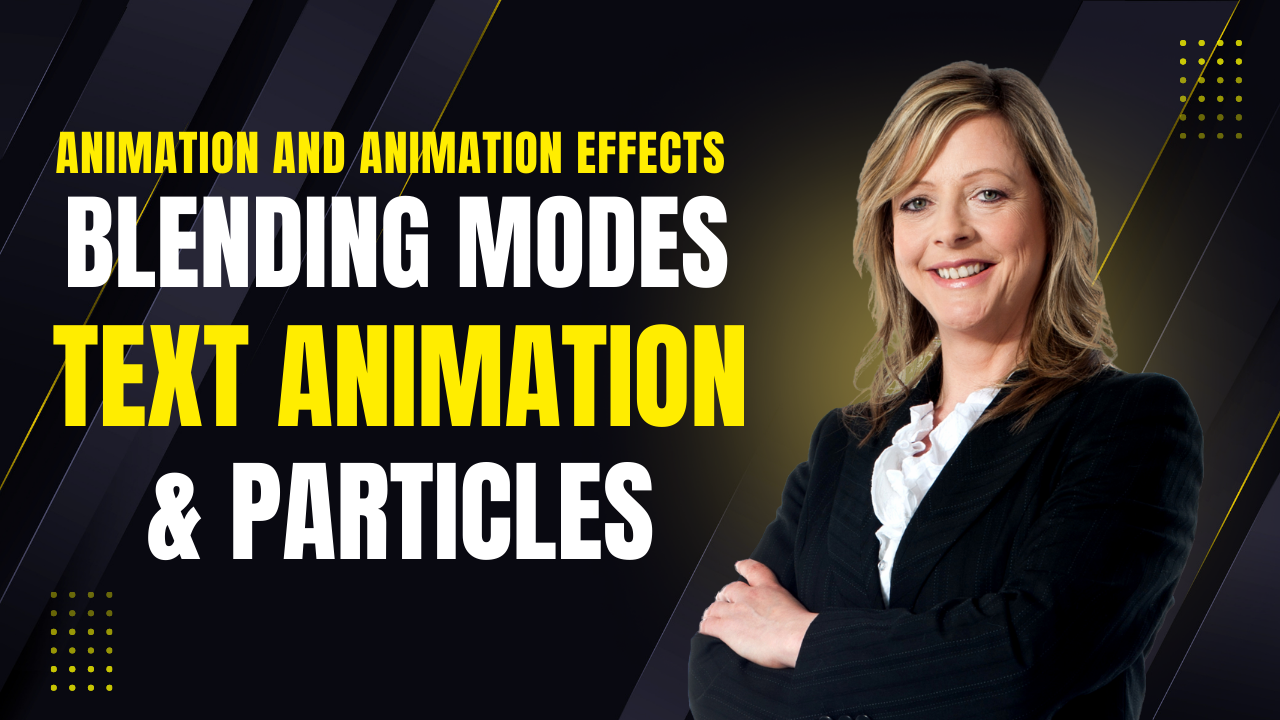
Created by - Anil Chauhan
Applying Effects Using Presets in After Effects
Blending Modes in After Effects ????️✨Blending Modes are used to control how layers interact with each other in your composition. They are essential for compositing, special effects, and creative looks in After Effects. By adjusting how the colors of one layer interact with the layers beneath it, you can create stunning effects and blends.1. How to Apply a Blending Mode1️⃣ Select the layer you want to apply a blending mode to. 2️⃣ In the Timeline, locate the Mode column. If it's not visible, right-click the column header and choose Columns > Mode. 3️⃣ Click on the Mode dropdown menu (default is "Normal"). 4️⃣ Choose a blending mode from the list.2. Common Blending Modes and Their Effects???? Normal Description: The default blending mode. No blending occurs, and the top layer completely covers the bottom layer. Use: Perfect when you want to keep the layer opaque. ???? Darken Description: This mode compares the colors of the top and bottom layers and keeps the darker pixel values. Use: Great for darkening a scene or combining textures for a grunge effect. Examples: Darken, Multiply, Color Burn. ???? Lighten Description: The opposite of Darken; this mode keeps the lighter pixels. Use: Ideal for brightening an image or combining light effects. Examples: Lighten, Screen, Color Dodge. ???? Overlay Description: A combination of Multiply and Screen. It multiplies dark pixels and screens light pixels, enhancing contrast. Use: Perfect for adding texture or creating a vintage/film look with high contrast. Example: Overlay (creates a balanced effect of dark and light areas). ???? Multiply Description: Multiplies the color values of the top and bottom layers, resulting in darker images. Use: Ideal for shadows or darkening images, especially with textures. It’s also commonly used for adding depth. Example: Adding a dark texture layer to a light background. ???? Screen Description: Inverts and multiplies the color values, brightening the bottom layer. Use: Excellent for highlighting and creating light-based effects (like glow effects or a white vignette). Example: Adding a light flare to a scene or enhancing brightness in a composition. ???? Soft Light Description: Softly lightens or darkens based on the brightness of the top layer. If the top layer is lighter, it lightens; if darker, it darkens. Use: Great for soft, subtle light effects or adding gradients to images. Example: Soft Light used to gently enhance the highlights or shadows of a scene. ???? Hard Light Description: A combination of Multiply and Screen, but with harsher results. It brightens light areas and darkens dark areas. Use: Often used for adding strong contrasts or creating dramatic lighting effects. Example: Hard Light can give a "spotlight" effect with high contrast. ???? Difference Description: Compares the colors of the top and bottom layers and subtracts the lighter values from the darker ones, producing colorful, contrasty results. Use: Creates interesting, often psychedelic effects and can be used for negative space or color distortion. Example: Great for experimental effects, or when combining textures with negative color schemes. ???? Hue, Saturation, Color, and LuminosityThese modes allow you to blend based on specific color attributes. Hue: Uses the hue of the top layer to modify the hue of the bottom layer, while preserving saturation and lightness. Saturation: Uses the saturation of the top layer to modify the saturation of the bottom layer, while preserving hue and lightness. Color: Combines hue and saturation of the top layer to affect the bottom layer, preserving the original luminance. Luminosity: Uses the luminance (brightness) of the top layer to modify the luminance of the bottom layer, while keeping hue and saturation intact. 3. Tips for Using Blending Modes✅ Layer Stacking: Layering multiple effects can create complex and stunning visual results. Try combining Overlay with Multiply for texture-heavy compositions. ✅ Texture Effects: Use Multiply or Overlay when combining images with textures for rich details. ✅ Highlight & Shadow Control: Use Screen and Multiply to emphasize highlights and shadows, giving your scene more depth. ✅ Experimental Look: For creative effects, try using Difference or Exclusion for more abstract results. ✅ Opacity Control: Adjust the opacity of the layer with the blending mode to fine-tune its effect on the composition. Need help with a specific blending mode or effect? Let me know! ✨Text Animation in After Effects ???????? Text animation in After Effects allows you to create dynamic, engaging titles, motion graphics, and creative visual effects for text elements. You can animate text properties (such as position, scale, opacity, and more) using various techniques like preset animations, keyframes, and effects. 1. Creating Basic Text Animations???? Adding Text 1️⃣ Select the Text Tool (Ctrl + T or Command + T) from the top toolbar. 2️⃣ Click in the Composition Panel and type your desired text. 3️⃣ Customize the font, size, and color using the Character Panel. ???? Basic Text Animation with Keyframes You can animate text properties (like position, opacity, or scale) manually with keyframes. Steps: 1️⃣ Select the text layer in the timeline. 2️⃣ Press the P key to reveal Position, S key for Scale, or T key for Opacity. 3️⃣ Click the Stopwatch icon next to the property you want to animate. 4️⃣ Move the playhead to a different time in the timeline and change the property values. 5️⃣ After Effects will automatically create a new keyframe. Repeat for further animations. 2. Using Text Animators (Preset Animations) After Effects has powerful text animators that allow you to animate individual characters, words, or lines. ???? Adding a Text Animator 1️⃣ Select the text layer. 2️⃣ Click the Add button (next to the layer name) and choose Animator. You can animate properties like Position, Opacity, Rotation, and Scale. 3️⃣ After selecting an animator, you can adjust the range selector to control when and where the animation happens. Animator Properties: Position: Move the text up, down, left, or right. Opacity: Fade text in or out. Scale: Make the text grow or shrink. Rotation: Rotate individual characters or the entire text. 3. Advanced Text Animation with Range Selectors Range Selectors give you more control over how text animates, allowing you to animate portions of the text based on characters, words, or lines. ???? Range Selector Controls: Start/End: Adjust where the animation starts and ends in the text. Offset: Shift the entire animation (left or right). Advanced: Offers finer control for easing, smoothness, or animating by characters or words. Example: 1️⃣ Add an Animator (e.g., Position) to the text. 2️⃣ In the Animator, click on the Range Selector to modify the start and end of the animation. 3️⃣ You can animate the Offset to create a "typewriter" effect by shifting the text position. 4. Using Text Animation Presets Text animation presets allow you to quickly apply complex animations without manually adjusting keyframes. ???? How to Use Text Animation Presets: 1️⃣ Go to Animation > Browse Presets. This opens Adobe Bridge with available text animation presets. 2️⃣ Drag and drop a preset onto your text layer. 3️⃣ You can further tweak the animation using the Timeline and Effect Controls panel. 5. Motion Graphics Templates (MOGRTs) After Effects allows you to create motion graphics templates (MOGRTs) for text animations, which can be easily reused across different projects or in Premiere Pro. ???? Creating a MOGRT for Text Animation: 1️⃣ Animate your text layer using keyframes or animators. 2️⃣ Once satisfied with the animation, go to File > Export > Motion Graphics Template. 3️⃣ Save it and share it for future use or import it directly into Premiere Pro. 6. Text Animation with Effects To make text animations more engaging, you can combine text animators with After Effects' wide range of effects. ???? Popular Effects for Text Animation: Gaussian Blur: Apply blur to the text for a smooth entrance or exit. Glow: Make the text light up with a soft glow effect. Wave Warp: Add a wave effect to create a "rippling" look for text. Turbulent Displace: Create distortion effects on the text for a more abstract look. 7. Text Animation Tips ✅ Easing: Apply Easy Ease (F9) or Graph Editor to smooth out animations and add natural flow. ✅ Animate by Character or Word: Use Range Selectors to animate text one character or word at a time for a dynamic effect. ✅ Use Multiple Layers: Stack text layers and animate them independently to create a multi-dimensional look. ✅ Layer Styles: Combine Layer Styles like Drop Shadow or Bevel and Emboss to give the text depth and make it stand out. Need help animating text in a specific way? Let me know! ????️✨Particles in After Effects ???????? Particles are a great way to add dynamic effects, textures, and motion to your compositions. In After Effects, particles are typically created using the CC Particle Systems II, Particular (from Red Giant’s Universe suite), or built-in particle-based effects. You can simulate a range of effects, from rain and fire to abstract motion and energy. 1. Using CC Particle Systems II (Built-In Particle System) CC Particle Systems II is a built-in After Effects effect that lets you generate particles and control their behavior. It’s great for creating effects like smoke, rain, fire, and explosions. ???? Steps to Create a Basic Particle Effect: 1️⃣ Create a new solid layer (Layer > New > Solid), and choose a color (black or white usually works). 2️⃣ Apply CC Particle Systems II: Effect > Simulation > CC Particle Systems II. 3️⃣ In the Effect Controls panel, you’ll see options to control the particle behavior: Producer: Controls where the particles emit from. Particle: Choose the shape of the particle (e.g., star, ball, cloud). Physics: Controls how the particles behave (e.g., gravity, wind). Velocity: Controls the speed at which the particles move. Particle Size: Adjusts the size of the particles. 2. Using Trapcode Particular (Advanced Particle System) If you need more advanced particle effects, Trapcode Particular by Red Giant is a powerful plugin. It gives you more control over the particles, their interactions, and visual complexity. ???? Steps to Create Particles with Trapcode Particular: 1️⃣ Create a new solid layer and choose a color. 2️⃣ Apply Trapcode Particular: Effect > RG Effect > Particular. 3️⃣ In the Effect Controls panel, you’ll see several sections: Emitter: Control where particles are emitted (point, box, sphere, etc.). Particles: Choose the particle type (e.g., cloudlets, stars, 3D objects). Physics: Control how particles behave (e.g., gravity, wind, turbulence). Auxiliary System: Adds additional layers of particles for even more complexity. Rendering: Change how particles are rendered (e.g., fade, smooth, or trail). 3. Particle Animation Controls Once you've applied a particle effect, you can control how the particles evolve over time using various settings: ???? Particle Speed & Direction Velocity: In both CC Particle Systems II and Particular, adjust the velocity of particles for speed and direction. Gravity: Apply gravity for a realistic downward force, perfect for smoke, fire, or falling objects. Wind: Simulate wind by adjusting the air resistance or turbulence for swaying or drifting particles. ???? Particle Shape & Size Particle Type: Choose between shapes like Circle, Star, Line, or Custom shapes using a texture or image. Size Over Life: Make particles grow or shrink over their lifetime. Opacity Over Life: Gradually fade particles as they age for a more realistic effect. ???? Particle Lifespan & Behavior Life: Control how long particles live before disappearing. This is useful for creating effects like fading smoke or sparks. Birth Rate: Increase or decrease how many particles are emitted over time. Turbulence: Add turbulence or random motion for more natural, chaotic behavior. 4. Using Particle Effects for Specific Looks Particles can be used for a wide range of effects: ???? Fire & Explosions: 1️⃣ Apply Trapcode Particular and choose a Point Emitter. 2️⃣ Use fire-like particle types (such as Cloudlets or Billowing Smoke). 3️⃣ Adjust turbulence for movement and size over life to make particles shrink or fade out. 4️⃣ Use Additive Blending to create a glowing, fiery look. ???? Snow & Rain: 1️⃣ Use CC Particle Systems II or Trapcode Particular. 2️⃣ Select a Sphere Emitter with white particle shapes for snow, or use streak particles for rain. 3️⃣ Set the life span to short (for rain) or long (for snow). 4️⃣ Control the velocity and gravity for realistic downward motion. ???? Abstract Motion: For abstract designs, particles can add texture, color, and unique animation effects. 1️⃣ Use smaller particle sizes and apply a custom texture for the particles (e.g., an image of stars or glitter). 2️⃣ Experiment with turbulence and random movement to create a fluid, chaotic effect. 3️⃣ Glow or blur the particles for a more ethereal, dreamy look. 5. Controlling Particle Colors You can customize the color of your particles for more vibrant and dynamic effects: ???? Color Over Life: 1️⃣ In Trapcode Particular, go to the Particle settings. 2️⃣ Use the Color Over Life graph to transition the particles' colors over their lifespan (e.g., from red to yellow for fire). 3️⃣ You can use gradient or set specific colors at different times in the particle’s life. 6. Camera & 3D Particles In both CC Particle Systems II and Trapcode Particular, you can work with 3D particles. ???? Working in 3D: 1️⃣ Enable the 3D Layer switch for your particle layer in the timeline. 2️⃣ Adjust the Emitter to be in 3D space, giving your particles depth and perspective. 3️⃣ Use a camera layer to animate the scene and create dynamic, floating particle effects in a 3D environment. 7. Advanced Tips and Tricks Particle Trails: Create trails by enabling motion blur or using the auxiliary system in Particular. Interacting Particles: Use particle collision or repulsion for more interactive effects, like particles bouncing off objects. Depth of Field: Use depth of field settings on the camera for a realistic blur of particles at different distances. Need help creating a specific particle effect? Let me know! ????✨
More detailsPublished - 3 Days Ago
Search
Popular categories
Adobe After Effects 2025
28Unreal Engine
14zbrush
10Maya Animation
8zbrush tutorial jewelry
7Maya 2025
6Latest blogs
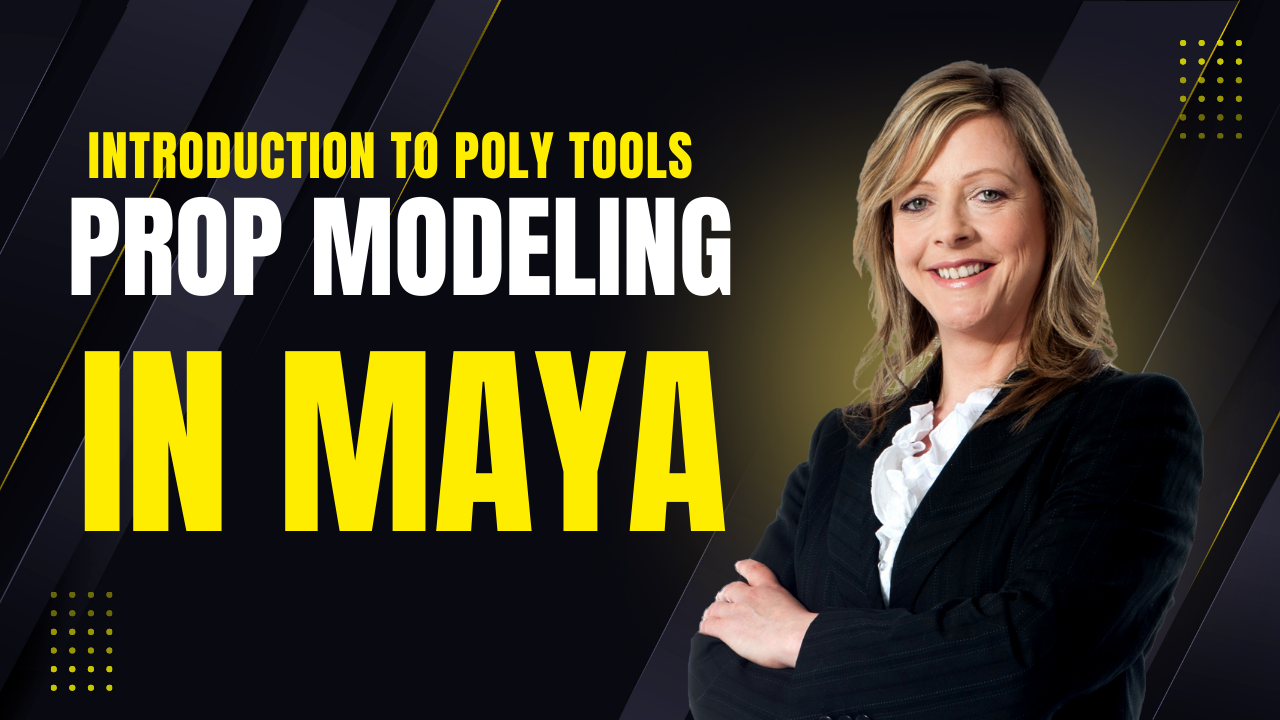
Mesh |Edit Mesh|Mesh Tools
4 Hours Ago
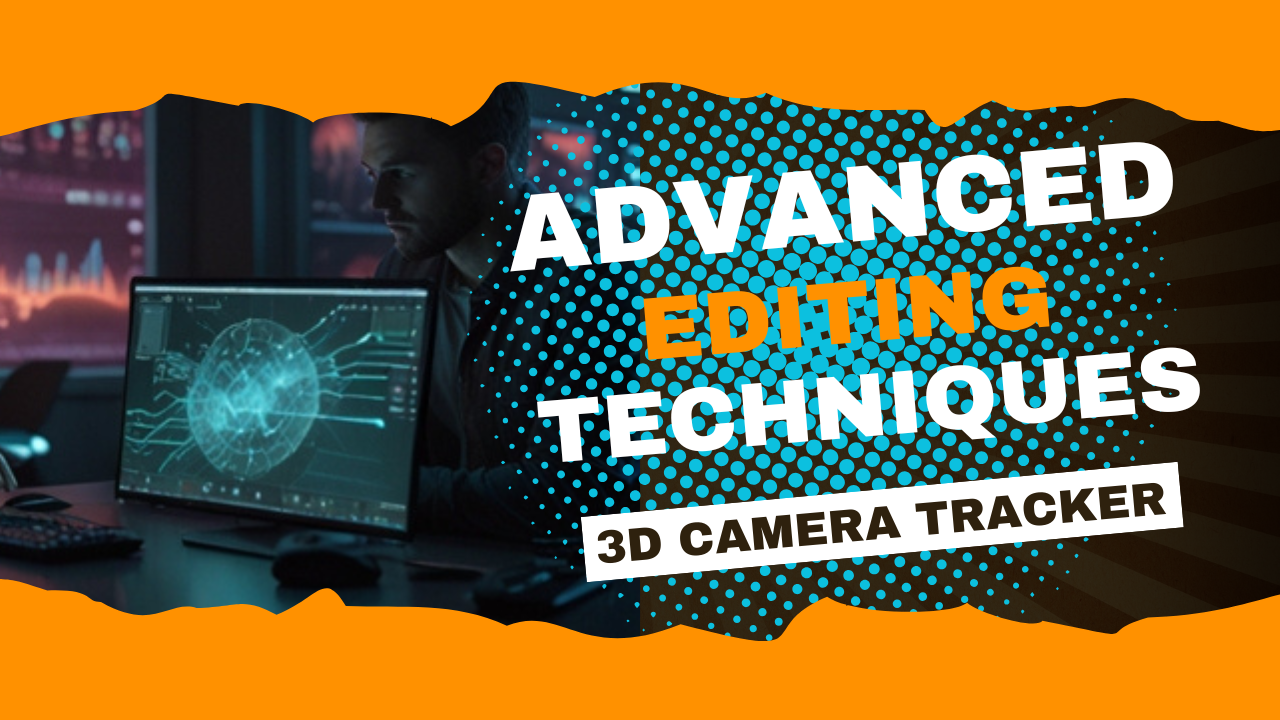
Advanced Editing Techniques
13 Hours Ago
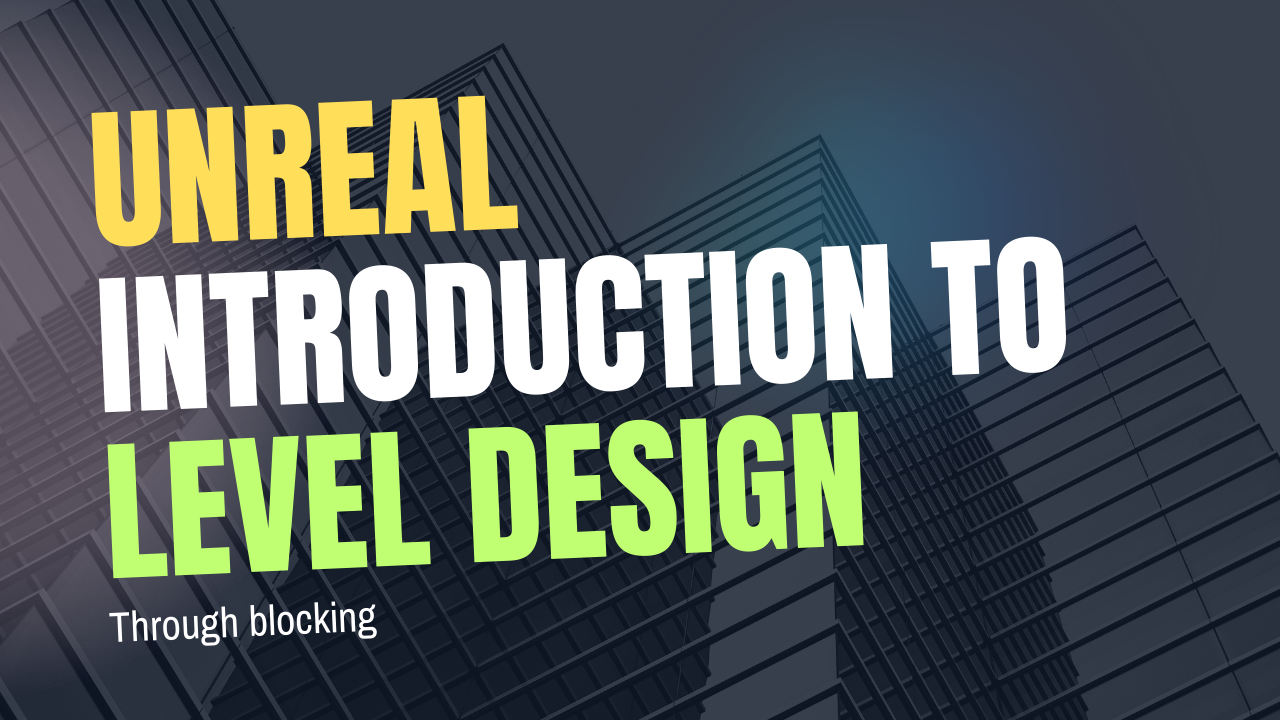
Introduction to Level Design Through Blocking in Unreal Engine
2 Days Ago
Write a public review